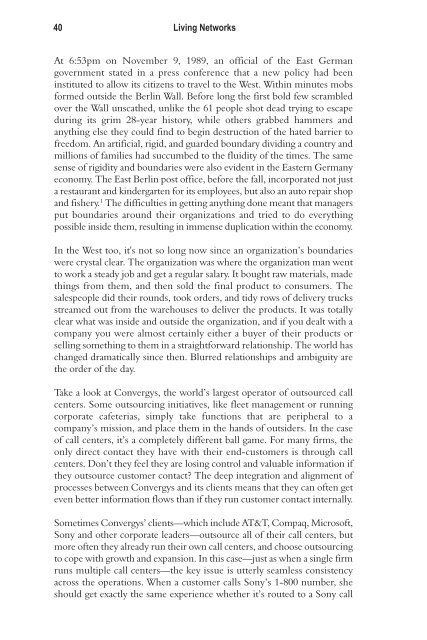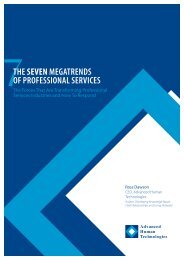Living Networks – Chapter 3: The New Organization - Ross Dawson
Living Networks – Chapter 3: The New Organization - Ross Dawson
Living Networks – Chapter 3: The New Organization - Ross Dawson
Create successful ePaper yourself
Turn your PDF publications into a flip-book with our unique Google optimized e-Paper software.
40 <strong>Living</strong> <strong>Networks</strong><br />
At 6:53pm on November 9, 1989, an official of the East German<br />
government stated in a press conference that a new policy had been<br />
instituted to allow its citizens to travel to the West. Within minutes mobs<br />
formed outside the Berlin Wall. Before long the first bold few scrambled<br />
over the Wall unscathed, unlike the 61 people shot dead trying to escape<br />
during its grim 28-year history, while others grabbed hammers and<br />
anything else they could find to begin destruction of the hated barrier to<br />
freedom. An artificial, rigid, and guarded boundary dividing a country and<br />
millions of families had succumbed to the fluidity of the times. <strong>The</strong> same<br />
sense of rigidity and boundaries were also evident in the Eastern Germany<br />
economy. <strong>The</strong> East Berlin post office, before the fall, incorporated not just<br />
a restaurant and kindergarten for its employees, but also an auto repair shop<br />
and fishery. 1 <strong>The</strong> difficulties in getting anything done meant that managers<br />
put boundaries around their organizations and tried to do everything<br />
possible inside them, resulting in immense duplication within the economy.<br />
In the West too, it's not so long now since an organization’s boundaries<br />
were crystal clear. <strong>The</strong> organization was where the organization man went<br />
to work a steady job and get a regular salary. It bought raw materials, made<br />
things from them, and then sold the final product to consumers. <strong>The</strong><br />
salespeople did their rounds, took orders, and tidy rows of delivery trucks<br />
streamed out from the warehouses to deliver the products. It was totally<br />
clear what was inside and outside the organization, and if you dealt with a<br />
company you were almost certainly either a buyer of their products or<br />
selling something to them in a straightforward relationship. <strong>The</strong> world has<br />
changed dramatically since then. Blurred relationships and ambiguity are<br />
the order of the day.<br />
Take a look at Convergys, the world’s largest operator of outsourced call<br />
centers. Some outsourcing initiatives, like fleet management or running<br />
corporate cafeterias, simply take functions that are peripheral to a<br />
company’s mission, and place them in the hands of outsiders. In the case<br />
of call centers, it’s a completely different ball game. For many firms, the<br />
only direct contact they have with their end-customers is through call<br />
centers. Don’t they feel they are losing control and valuable information if<br />
they outsource customer contact <strong>The</strong> deep integration and alignment of<br />
processes between Convergys and its clients means that they can often get<br />
even better information flows than if they run customer contact internally.<br />
Sometimes Convergys’ clients—which include AT&T, Compaq, Microsoft,<br />
Sony and other corporate leaders—outsource all of their call centers, but<br />
more often they already run their own call centers, and choose outsourcing<br />
to cope with growth and expansion. In this case—just as when a single firm<br />
runs multiple call centers—the key issue is utterly seamless consistency<br />
across the operations. When a customer calls Sony’s 1-800 number, she<br />
should get exactly the same experience whether it’s routed to a Sony call







